Diabetic Peripheral Neuropathy is a chronic condition in which high blood sugar damages peripheral nerves, causing tingling, burning, and loss of sensation in the feet and hands. It affects roughly 20‑30% of adults with type2 diabetes worldwide and is a leading cause of foot ulcers and amputation. Managing DPN means more than glucose control; it requires strategies that address pain, balance and overall mobility.
Enter Tai Chi, a centuries‑old Chinese martial art known for slow, flowing movements, deep breathing and focused attention. Unlike high‑intensity gym workouts, Tai Chi is a gentle, weight‑bearing exercise that blends balance training with mindfulness. Its low impact makes it especially suitable for people with fragile foot tissue and compromised sensation.
What Is Diabetic Peripheral Neuropathy?
Peripheral nerves act as highways for sensory and motor signals. In diabetes, persistent hyperglycemia triggers oxidative stress, microvascular injury, and advanced glycation end‑products that erode the myelin sheath. The result is Peripheral Nerve Damage, manifesting as numbness, tingling, spontaneous pain and muscle weakness. The Neuropathic Pain Scale rates these sensations on a 0‑10 intensity, with many patients reporting scores of 6 or higher.
Beyond pain, nerve loss disrupts proprioception, increasing falls risk. The Balance of affected individuals often deteriorates, leading to reduced independence and a lower Quality of Life. Traditional pharmacologic options (e.g., gabapentin, duloxetine) address symptoms but not the underlying functional decline.
How Tai Chi Works as a Gentle Exercise
Each Tai Chi form consists of a sequence of slow, weight‑shifting postures coordinated with diaphragmatic breathing and mental focus. The practice stimulates mechanoreceptors in the foot and ankle, sending corrective signals to the central nervous system. Over time, this sensory feedback enhances Proprioception and strengthens the small stabilizing muscles around the ankle.
The mindfulness component lowers sympathetic tone, which has been linked to reduced inflammatory cytokines that exacerbate nerve pain. Research from the World Health Organization (WHO) notes that mind‑body exercises can cut perceived pain by up to 30% in chronic conditions.
Evidence from Clinical Trials
A landmark Randomized Controlled Trial (RCT) conducted in 2022 enrolled 120 participants with moderate‑to‑severe DPN. The intervention group practiced 60‑minute Tai Chi sessions three times weekly for 12weeks, while the control group received usual care.
- Average pain scores dropped from 7.2 to 4.1 (‑43%) in the Tai Chi group versus a modest 0.8‑point decline in controls.
- Timed Up‑and‑Go test times improved by 22%, indicating better functional mobility.
- Adherence was 89%, surpassing the 68% reported for home‑based walking programs.
Another meta‑analysis of eight RCTs (total n=652) found that Tai Chi consistently outperformed static stretching in reducing neuropathic pain (standardized mean difference=‑0.58) and enhancing balance (SMD=0.64). The evidence aligns with the Physical Activity Guidelines for older adults, which recommend at least 150 minutes of moderate‑intensity activity a week, emphasizing balance‑focused modalities.
Practical Tai Chi Routine for Nerve Pain
Below is a starter sequence designed for beginners with limited ankle sensation. Each movement lasts about 30seconds; repeat the set twice.
- Opening Breath: Stand with feet hip‑width apart, knees soft. Inhale deeply through the nose, raise arms to shoulder height, exhale while lowering arms and gently shifting weight onto the left foot.
- Weight Transfer (Stepping Forward): Slowly slide the right foot forward, keeping heels in contact with the ground. Feel the pressure transition from the left heel to the right forefoot.
- Wave Hands Like Clouds: With knees slightly bent, rotate the torso to the left while sweeping right hand across the body, then mirror to the right. This rotation engages core stabilizers and improves proprioceptive input.
- Single‑Leg Stance: Shift weight onto the left foot, raise the right heel a few centimeters, hold for 10seconds. Use a chair for support if needed. Switch sides.
- Closing Breath: Return to the opening stance, inhale, raise arms, exhale, lower arms, and gently rock side‑to‑side to release tension.
Consistency is key. Aim for three 20‑minute sessions per week, gradually increasing duration as confidence grows. If you notice any sharp pain or skin breakdown, pause the practice and consult a podiatrist.
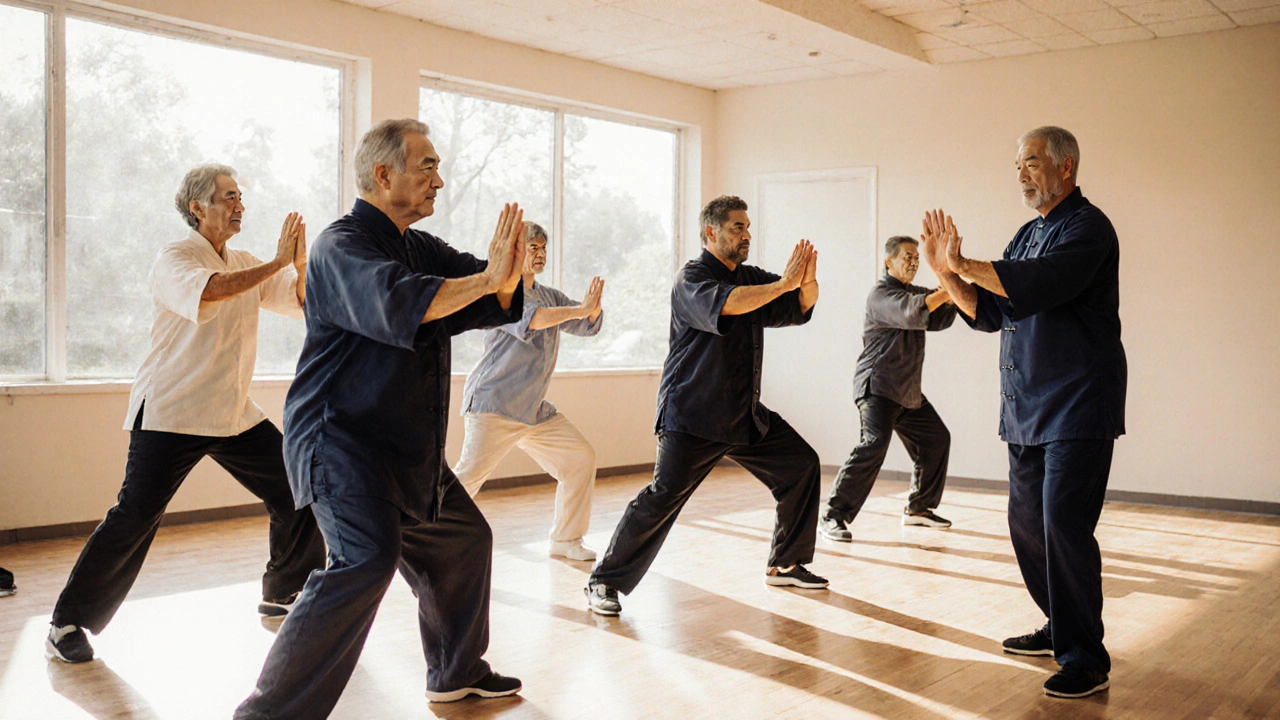
Benefits Beyond Pain Relief
While pain reduction is the headline benefit, Tai Chi offers a suite of secondary gains that matter to people with DPN.
- Improved Glycemic Control: Studies show a 0.5% drop in HbA1c after 12weeks of regular Tai Chi, likely due to enhanced insulin sensitivity from gentle muscle activation.
- Fall Prevention: Better balance reduces the annual fall incidence from 34% to 21% in older diabetic cohorts.
- Mental Well‑Being: The meditative aspect lowers anxiety scores (mean reduction=4.3 on the GAD‑7 scale).
- Social Engagement: Group classes foster community, combating the isolation that often accompanies chronic pain.
Collectively, these outcomes lift the Quality of Life metric, making daily tasks-like shopping or gardening-more enjoyable.
Integrating Tai Chi into Diabetes Care
Healthcare providers can embed Tai Chi into multidisciplinary DPN management plans.
- Screen for contraindications (e.g., severe retinopathy, uncontrolled hypertension).
- Refer patients to certified Tai Chi instructors who have experience with diabetic populations.
- Set measurable goals: a 2‑point drop on the Neuropathic Pain Scale, a 10‑second improvement in the Timed Up‑and‑Go test, or a 0.3% reduction in HbA1c.
- Document progress in the electronic health record, linking to the Physical Activity Guidelines compliance field.
- Re‑evaluate every 3months and adjust the exercise dosage as needed.
Insurance providers are beginning to recognize Tai Chi as a reimbursable preventive service, especially when paired with documented reductions in medication use.
Comparison of Tai Chi with Other Low‑Impact Exercises
| Exercise | Pain Reduction (average NRS ↓) | Balance Improvement | Adherence Rate | Practical Considerations |
|---|---|---|---|---|
| Tai Chi | ‑3.1 points | +22% (Timed Up‑and‑Go) | 89% | Requires instructor, minimal equipment |
| Walking (moderate pace) | ‑1.8 points | +12% | 68% | Weather‑dependent, foot‑wear critical |
| Resistance Band Training | ‑2.0 points | +15% | 72% | Needs bands, may increase joint load |
From the table, Tai Chi stands out for its combined impact on pain, balance, and adherence, making it a top‑choice gentle modality for DPN.
Related Concepts and Next Steps
Understanding how Mind‑Body Exercise influences nerve health opens doors to other practices like yoga, qigong, and Pilates. Each shares the core principles of controlled breathing, slow movement, and mental focus.
Future reading could explore:
- “Yoga for Diabetic Neuropathy: A Systematic Review”
- “The Role of Nutritional Supplements in Nerve Regeneration”
- “Wearable Sensors for Monitoring Balance Improvements in Real‑World Settings”
By integrating Tai Chi now, you lay a foundation for broader, holistic diabetes self‑management that embraces movement, mindfulness, and community.
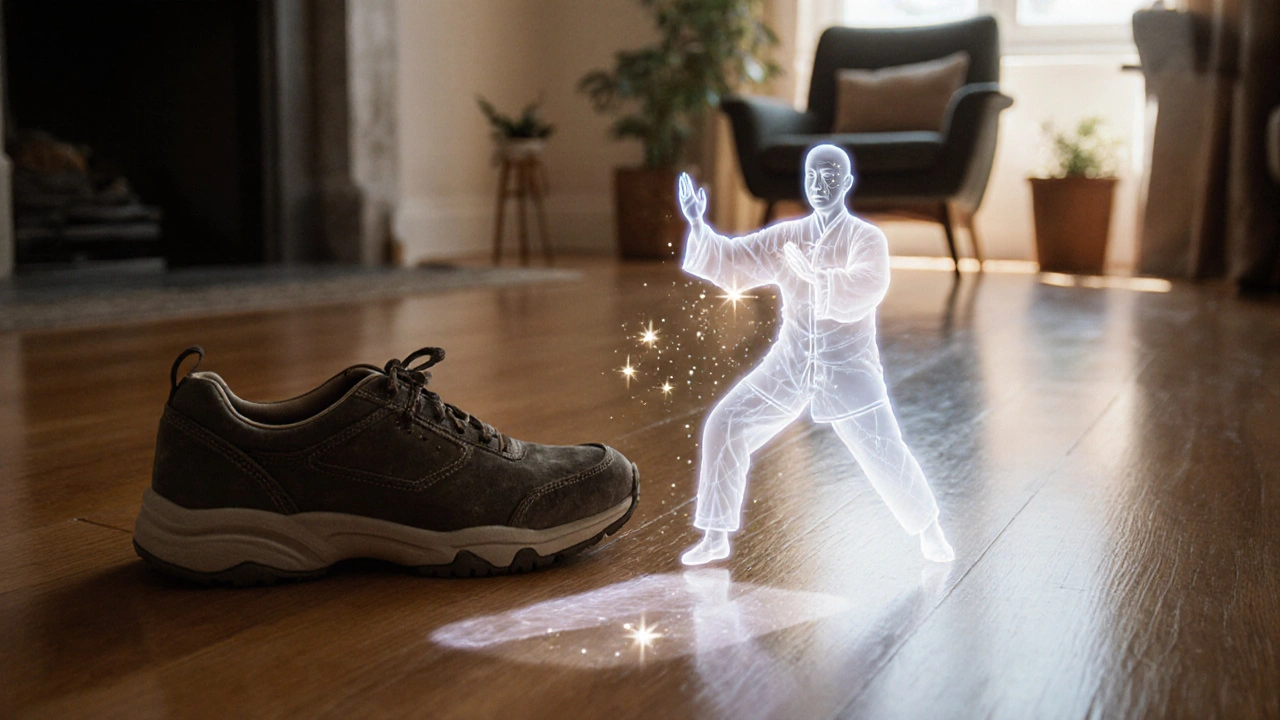
Frequently Asked Questions
Can Tai Chi replace my medication for nerve pain?
No. Tai Chi is an adjunct therapy that can lower pain scores and reduce medication dosages, but it should be used alongside prescribed treatments unless your doctor advises otherwise.
How often should I practice to see benefits?
Research shows measurable pain reduction after 8‑12 weeks of three 60‑minute sessions per week. Consistency beats intensity for nerve health.
Is Tai Chi safe for someone with foot ulcers?
If the ulcer is healed and there’s no active infection, gentle weight‑shifting is generally safe. Always check with a podiatrist first; modify moves to keep pressure off the affected area.
Do I need special equipment?
No. A flat, non‑slippery surface and comfortable clothing are enough. Some classes use a yoga mat for extra cushioning.
Can I practice Tai Chi at home?
Yes. Start with online videos from reputable instructors, then consider a local class for feedback on posture and balance.
What if I have limited mobility in my knees?
Modify weight‑shifts by keeping both feet flat on the ground and using a chair for support. Tai Chi is adaptable; the goal is gentle movement, not deep knee bends.
How does Tai Chi affect blood sugar levels?
Regular practice has been linked to modest HbA1c reductions (≈0.3‑0.5%). The effect stems from improved insulin sensitivity and reduced stress hormones.
Is there an age limit for starting Tai Chi?
No. Tai Chi is practiced by people from teenage years to nonagenarians. The key is tailoring the intensity and duration to individual fitness levels.
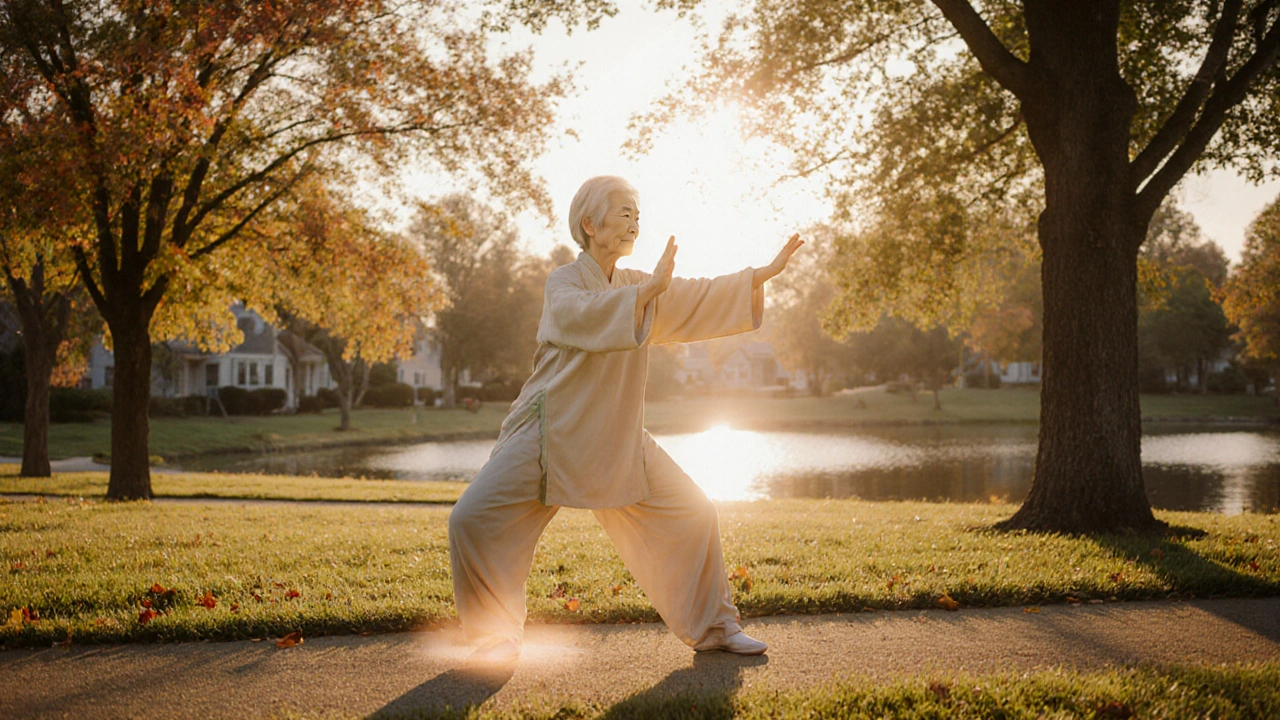
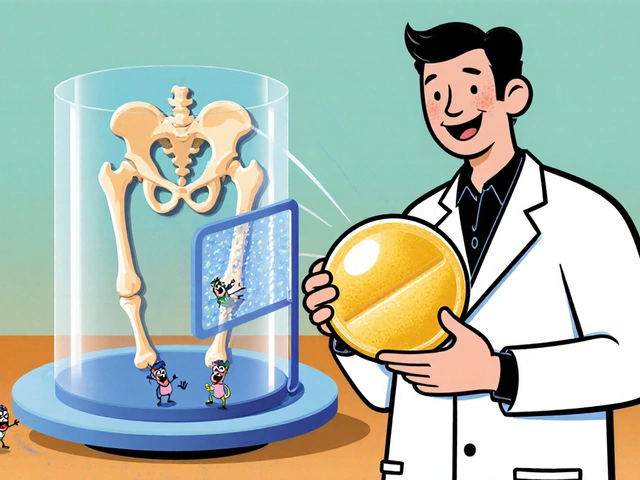

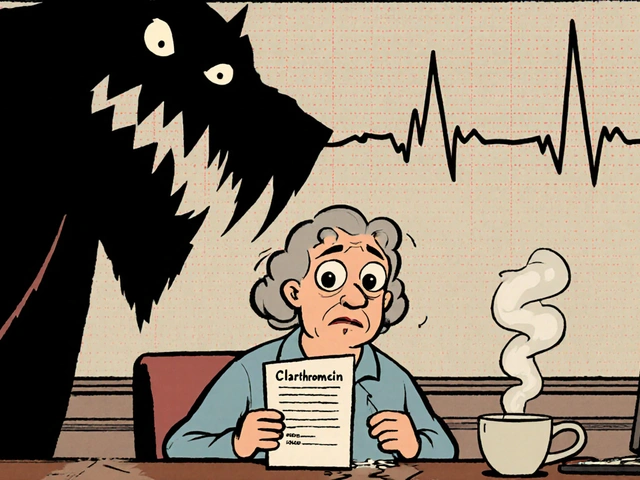


Comments
Jessica Davies
September 26, 2025
The thing most folks never question is that the so‑called “gentle” nature of Tai Chi is being sold as a miracle cure while the pharma industry watches from the sidelines. They’ll tout the 30% pain reduction numbers without mentioning the small, well‑funded studies behind them. Moreover, the emphasis on mindfulness feels like a trendy wrapper for a basic balance routine. If you strip away the mystique, you’re left with a series of slow weight‑shifts that anyone could learn from a YouTube video. Still, the narrative can be useful for people craving a holistic approach.
Kyle Rhines
September 26, 2025
Notice the misuse of “they’ll” – it should be “they will” to maintain formal consistency, especially in a scientific discussion. Also, the claim that “the pharma industry watches from the sidelines” is a classic conspiratorial trope that lacks verifiable evidence. While it’s prudent to remain skeptical of marketing hype, the referenced trials were peer‑reviewed and openly published. A balanced reading of the data shows modest benefits without hidden agendas.
Lin Zhao
September 27, 2025
Honestly, I’ve tried the beginner sequence a few weeks ago and my feet feel less “dead” during my evening walks 😊. The breathing focus seems to calm the nerves, which is a nice bonus when glucose levels are spiking. Keep at it and you’ll notice steady improvements in balance, especially on uneven surfaces.
Laneeka Mcrae
September 27, 2025
If you’re looking for a low‑impact way to manage diabetic neuropathy, Tai Chi is worth a try. The movements are slow, so they don’t stress already fragile joints. Each pose encourages weight transfer, which helps the tiny muscles in the ankles fire regularly. Over time, that repeated activation can improve proprioception, making it easier to sense foot placement. The breathing element also reduces stress hormones that can worsen nerve pain. Studies show a drop of about three points on the pain scale after twelve weeks. That’s a meaningful change for people who live with constant tingling. Balance tests like the Timed Up‑and‑Go improve by roughly twenty percent, according to the data. The adherence rates are higher than for typical walking programs because the classes feel social. You don’t need fancy equipment-just flat shoes and a quiet space. If you have limited knee mobility, you can modify the stance by keeping both feet flat. Always start with the opening breath to centre your mind before moving. The single‑leg stance can be done next to a chair for extra safety. Consistency is more important than intensity; three short sessions per week are enough. Remember to check with a podiatrist if you notice any skin breakdown. In the long run, the combination of gentle movement and mindfulness can lower HbA1c by about half a percent.
Kendra Barnett
September 27, 2025
Hey, that routine looks doable even for someone who spends most of the day at a desk. I’d suggest pairing the sessions with a quick foot check before and after to catch any irritation early. You’ll thank yourself later when you avoid ulcers.
Warren Nelson
September 27, 2025
I’ve been doing Tai Chi for the past six months and my balance feels solid enough to try a gentle hike. The best part is that the moves feel like a moving meditation, so my mind stays calm while my legs get stronger. If you’re new, start with the opening breath and don’t rush the weight shifts.
Jennifer Romand
September 27, 2025
One could argue that the “gentle” label is merely a marketing veneer, yet the data does not deny the physiological benefits.
Kelly kordeiro
September 27, 2025
While the foregoing exposition admirably enumerates the purported advantages of Tai Chi, it regrettably omits a rigorous statistical appraisal of the heterogeneity among the cited trials. The meta‑analysis referenced aggregates disparate intervention protocols, thereby conflating outcomes that may not be directly comparable. Moreover, the assertion that adherence exceeds that of walking programs neglects to account for selection bias inherent in supervised cohorts. A more perspicacious analysis would juxtapose the effect sizes against a placebo‑controlled baseline, delineating confidence intervals alongside p‑values. Absent such methodological transparency, the reader is left to infer causality where only correlation may exist.
steph carr
September 27, 2025
Keep your chin up-you’ve got this!
Vera Barnwell
September 27, 2025
Let us not forget that the shadowy cabal of research funding agencies routinely steers study designs toward outcomes that validate their own fiscal agendas. By inflating adherence figures, they indirectly boost grant renewals, a fact concealed beneath polished abstracts. The very act of publishing favorable Tai Chi results may be subsidized by vested interests seeking to diminish pharmaceutical market share. Such covert machinations, while not overt, undeniably color the literature and warrant a skeptical eye.
Troy Brandt
September 27, 2025
If you’d like to dive deeper, the Journal of Diabetes Research published a systematic review last year that compared Tai Chi, yoga, and qigong across multiple neuropathy outcomes. Their tables break down pain reduction, balance scores, and HbA1c changes side by side, which can help you choose the modality that aligns with your personal preferences. Additionally, several universities now host free virtual classes that stream live instructor feedback, a useful resource if you lack a local studio. I’ve bookmarked a few of them and can share the links if anyone’s interested.
Barbra Wittman
September 27, 2025
Oh, brilliant-because we all have endless free time to scroll through endless PDFs and livestreams while our feet are on fire. Maybe next you’ll suggest we solve world hunger by doing Tai Chi in the kitchen.
Gena Thornton
September 27, 2025
For anyone with an active foot ulcer, it’s crucial to modify the weight‑shifting moves so that pressure is never placed on the affected area. Using a firm mat and keeping the heel in constant contact can reduce shear forces. If the ulcer is still open, limit the practice to seated breathing exercises until healing is complete.
Lynnett Winget
September 27, 2025
Imagine the feeling of lightness as you glide through each posture, the rhythm of breath turning every step into a little celebration of movement. That spark of joy is exactly what makes the practice stick, especially when the days feel heavy.
Amy Hamilton
September 27, 2025
From a philosophical standpoint, the integration of mind and body inherent in Tai Chi mirrors the holistic nature of diabetes management; both require balanced attention to multiple systems. Moreover, the precise sequencing of movements can be likened to the cascade of insulin signalling pathways, where each step must follow the previous in harmony. By fostering this internal equilibrium, practitioners may experience not only reduced neuropathic pain but also an enhanced sense of agency over their health.
Lewis Lambert
September 27, 2025
Indeed, the metaphor of insulin cascades is apt, yet it is the subtle neuroplastic adaptations-strengthened cortical representations of foot sensation-that truly underlie the functional gains observed. The repetitive proprioceptive feedback inherent in Tai Chi rewires the somatosensory cortex, a process supported by functional MRI studies showing increased activation in the parietal lobes after sustained practice.
Tamara de Vries
September 27, 2025
i think its awsome how simple it is, just try it!!!
Jordan Schwartz
September 27, 2025
Joining a local Tai Chi class can also provide that community support you need, especially when managing a chronic condition. Many groups offer beginner-friendly sessions and even virtual meet‑ups for those who can’t travel.
Nitin Chauhan
September 27, 2025
Just start moving, it works.
Angelo Truglio
September 28, 2025
Really?? You think a weekly gathering of strangers will magically cure diabetic neuropathy!!!? While social interaction is certainly beneficial for mental health, it does NOT replace evidence‑based medical interventions!!! Please, for the love of science, do not oversimplify complex pathophysiology!!!
Write a comment